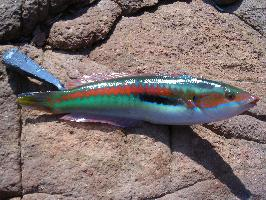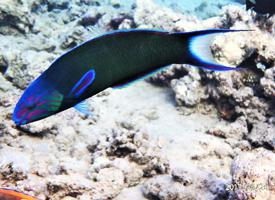
Description de l'animal
The Mediterranean rainbow wrasse, scientifically known as Coris julis, is a strikingly vibrant species of fish that graces the shallow waters of the Mediterranean Sea, as well as the eastern Atlantic Ocean, from the British Isles to Senegal, including the Azores, Madeira, and the Canary Islands. This species belongs to the family Labridae, which is renowned for its brightly colored members, and the Mediterranean rainbow wrasse is no exception with its dazzling hues and dynamic patterns.Adults of this species can reach lengths of up to 25 centimeters, although most individuals are commonly found to be smaller. The Mediterranean rainbow wrasse exhibits remarkable sexual dimorphism, meaning males and females differ significantly in their appearance. Females and juvenile males, known as initial phase (IP) individuals, typically display a muted palette of colors; their bodies are mainly olive-green or brownish, adorned with white stripes that run longitudinally along their sides. This camouflage helps them blend into their rocky and sandy surroundings, providing protection from predators.
In contrast, the terminal phase (TP) males showcase an array of brilliant colors from which the species derives its common name. Their bodies are a vivid blue or green, highlighted with bright orange to red stripes along their sides and back. The head is often a striking mix of green and blue with pink or orange lines radiating around the eyes, adding to their allure. This flamboyant display is not just for show; it plays a crucial role in attracting females during the breeding season and establishing dominance among males.
The Mediterranean rainbow wrasse is a diurnal species, active during the day and retreating to the safety of the seabed at night where it burrows into the sand to sleep. This behavior not only provides protection from nocturnal predators but also from the strong currents and rough seas that can occur in their natural habitats.
Diet-wise, the Mediterranean rainbow wrasse is omnivorous but shows a preference for small invertebrates such as mollusks, crustaceans, and echinoderms. Their diet reflects their role in the ecosystem as both predator and cleaner fish; juveniles, in particular, are known to pick parasites and dead skin off larger fish, providing a valuable service to their marine community.
Reproduction in this species is fascinating, with the Mediterranean rainbow wrasse being protogynous hermaphrodites. This means that all individuals are born female, with some transforming into males as they mature. This transformation is triggered by social factors, such as the absence of a dominant male, ensuring that there is always a balance for breeding purposes.
The Mediterranean rainbow wrasse is a resilient species, currently not facing any immediate threats of extinction. However, like many marine species, it could be affected by the overarching threats to ocean health, such as pollution, habitat destruction, and the impacts of climate change. Conservation efforts and continued research are vital to ensure that this colorful jewel of the Mediterranean and Atlantic continues to thrive in its natural habitat.
Animaux similaires
Nouvelles photos d'animaux
Top 10 des animaux
- Dolphin gull (Leucophaeus scoresbii)
- Japanese macaque (Macaca fuscata)
- Stone loach (Barbatula barbatula)
- Greek tortoise (Testudo graeca)
- Russian tortoise (Testudo horsfieldii)
- Galápagos tortoise (Geochelone nigra complex)
- Diana monkey (Cercopithecus diana)
- Moustached guenon (Cercopithecus cephus)
- Common flying dragon (Draco volans)
- Galápagos penguin (Spheniscus mendiculus)
